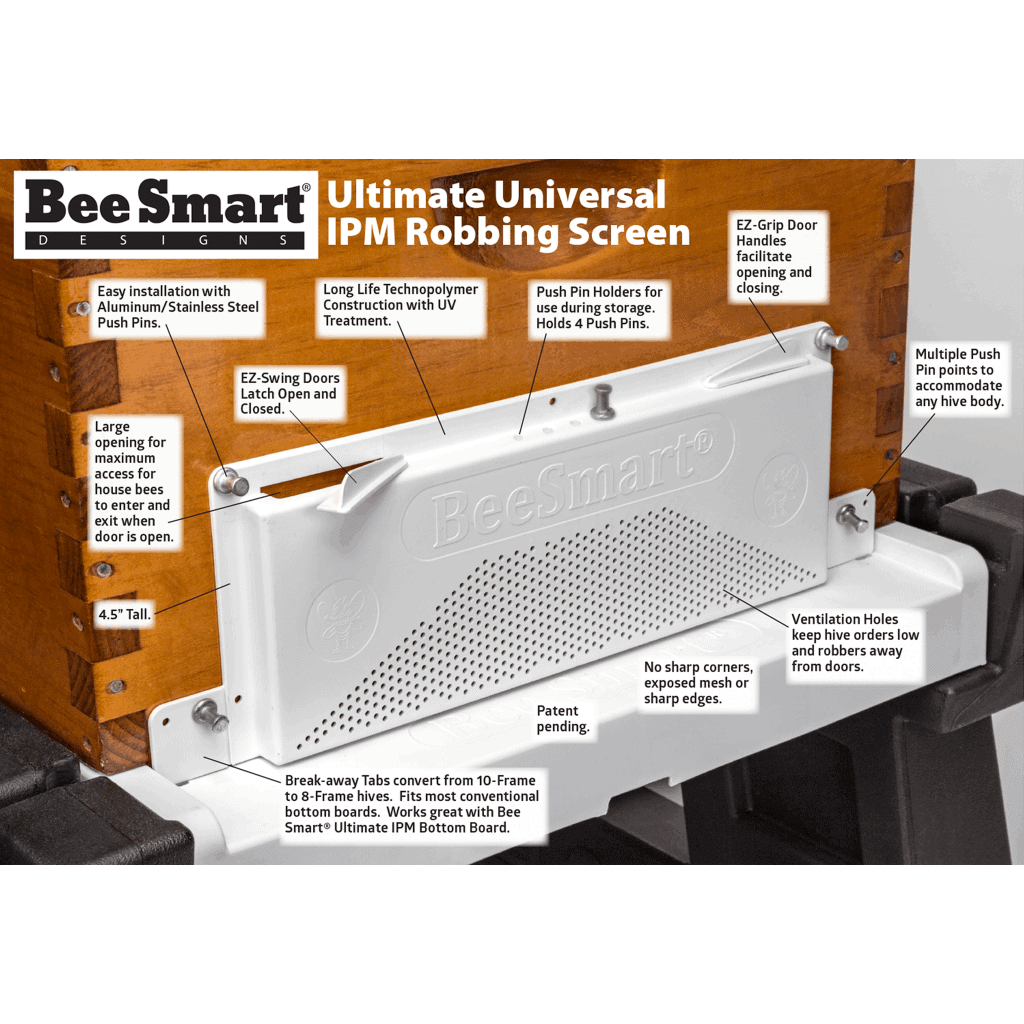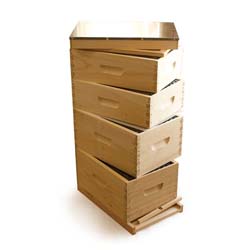Seasonal transitions by our bees
It seems every year is different in some way and here in Central Oregon we are running what appears to be a couple weeks behind a typical season. That’s a good thing because it means the nectar flow is still running strong. Soon we will make that transition from summer growth and the management issues associated with that growth, to preparing for winter and next season. In fact, your bees have likely already made the change from expansion to contraction, though you may not have noticed yet.
After the summer solstice your colony will begin to contract as the queen lays fewer eggs. We don’t always notice because of the huge number of bees still emerging from eggs laid in June. But as beekeepers we need to be aware that our colonies are making the shift from growth. As the seasons change there are a number of issues that come to mind. Simply adjust the following information to your own locale.
The wet spring and cooler weather in Central Oregon has kept the nectar flow going strong. A close eye must be kept on our hives, even though we know the season of expansion is coming to an end. The bees are still filling honey supers faster than we might expect and I’ve seen a number of hives go from just 3 frames of honey in the super to having nearly a full box…in just two weeks!
Adding boxes and encouraging use
Adding a new box is, of course, an option here. But as the bees adjust their activities to prepare for fall and winter they may resist moving up into that new box, even though the additional room is needed. As I did just today, there is a way to add a box to a hive that helps get the bees up and using that new box, while holding down the urge to swarm.
The following approach can be used any time you add a box as long as the night time temperatures are not low and certainly not when freezing. When it’s that cold the bees will move back down to cluster in the lower box and the brood you moved up will freeze.
Today I added a box to a colony that was using 90% of the frames in the top box. Remember the 70 percent rule – when the bees are using seventy percent of the frames it’s time for a new box. Yes, this one got away from me a bit!
So I took a new box, set it beside the hive and pulled two frames of brood from the outside edges of the brood nest (from within the box on which the new box will rest) and put the frames into the middle of the new box. This is called priming. It brings the bees right up into the new box immediately, since the nurse bees won’t abandon brood. It also creates space in the box below. As long as the nights are not too cold this is a good practice to follow whenever adding a new box to a hive.
Using queen excluders – and how to avoid them (if you wish!)
Another practice the change in seasons offers is the use of queen excluders. So let’s take a quick review. Many books and websites talk about using excluders to prevent the queen from laying eggs and raising brood in the honey super from which you plan to take honey. Queen excluders are effective and do indeed keep the queen out of the honey super just as intended. But they have also earned the nickname of “honey excluder” for a very good reason.
Queen excluders force worker bees to work harder to get through them and into the upper box. Sometimes the workers will simply try to stash the new nectar in the boxes below, instead of going through the queen excluder. This can result in little space for the queen to lay, a condition referred to as honey bound. So here is a simple way around using a queen excluder if it’s something you’d like to try.

With the queen unrestricted and able to lay eggs, even in your intended honey super, take note through the season of the frames in which brood is raised. Often times it will only be the middle two or three frames. Though these frames may be re-purposed for the storage of honey later in the season, these are not frames from which you wish to take honey.
Why is that, you might ask? Most people wouldn’t know the difference and some say it’s not a big deal….but you should know that the larva defecate in each brood cell prior to spinning their cocoons (as well as the mites, if present). They also molt a number of times.
It’s not the best place to get your honey!
And just how did the honey get there if they are raising brood in those cells? As the population of bees shrinks (remember the queen has been reducing her egg laying since about June 21 – longest day) she will quit laying in the upper box. The bees will then “backfill” cells previously used for brood, with honey.
Let’s say you know that two frames in your honey super were used to raise brood. When you harvest your honey remove those frames and swap them with frames of honey in lower box(es) that contain pure honey and which never had brood. The bees are left with the same amount of honey, but they don’t care if some of their honey is stored in cells where brood was raised. You on the other hand get pure comb honey that never had any brood in it.
One final reminder about queen excluders. It’s a beekeepers personal choice whether to use them. We all make many personal choices about beekeeping and the various approaches to management, so don’t be afraid to use a queen excluder if that fits your own individual style.
But please remember to do one important thing. Remove the queen excluder before winter. Most colonies move up into the upper box over the course of the winter and if the queen excluder is not removed then the queen will be left behind and freeze to death. You’d be surprised at how often this happens.
Bee escapes
Another piece of equipment used this time of year is the bee escape. This is a device allowing bees to move down from the honey super to cluster during the nights cooler temperatures but does not allow them to move back up. There are a number of variations available on the market but I like the one that fits in the hole in the inner cover. It’s easy to carry to the bee yard and does a good job.
Regardless of the kind you might choose, escape boards are designed to remove the bees from honey supers without using a fume board and chemicals. Bee escapes work best if you give them a couple days to do their job.

The threat of robbing
For the Central Oregon area this is normally the time of year I begin thinking about the coming dearth – that is, few or no flowers blooming. The bees can get defensive when a dearth is on so don’t be surprised when that sweet bunch of girls you’ve spent time with suddenly turn nasty – at least a little bit.
We aren’t there just yet in my part of the world, but I mention it here because Central Oregon typically dries out by the end of July and it’s something the beekeeper needs consider with their own locale in mind. An August dearth can lead to robbing of your weaker hives by stronger colonies and this also brings to mind those nasty pests of hornets and yellow jackets. I haven’t seen huge numbers yet but they are out there and their numbers will soon be rising fast.
Another one of the pieces of equipment you may want to consider making use of is the robber screen. They can be helpful in preventing robbing by yellow jackets as well as other colonies of bees. To be effective they must be placed on the hive prior to the beginning of robbing. For me it’s always a bit of a guessing game as to when to put them on. Put them on now for example (while the nectar flow is strong) and I will disrupt (slow down) the bees work of bringing in honey. Our nectar flow is running a little later this year and is still quite strong, so I’m reluctant to make the bees work harder when they are bringing in tons of that sweet golden nectar.
The timing is up to each of us as we judge where we are in the season, but if you are too late and robbing gets started the robbing screens won’t be nearly as effective. The time is getting near.

Removing honey
A note to help with timing. Typically we don’t gain honey in a honey super (for our use) after about the 1st of August. This date will, of course, vary depending on where you live but after a few seasons you will become familiar with these seasonal changes.
The bees are still bringing in nectar of course, but it won’t show up as more frames of honey in your honey super. The population is still quite high and the use of honey begins to approach the level of what the bees are able to find and bring into the hive. Additionally, the bees are backfilling in places where brood was laid so you won’t see much or any gain at all in the honey super. I normally remove all honey supers (honey for me) about the first of August, but that is always a determination made based on the way each year goes. This year the flow remains strong.
Staying on top of mite counts
This time of year also brings with it the issue of mites. We would all be blessed with a level of mites at 1 percent or so, but most of us are going to find levels around 3 to 5 percent. A level of mites that high needs to be treated. Some folks wait until August, but the high temperatures can interfere with the use of some treatment types, while others choose to treat and get after their mites in July.
Regardless of when you choose to deal with mites keep in mind that honey supers should be removed prior to treating for mites. And finally, you will want to conduct mite counts at the end of August (adjust to your own locale) and make sure they are under control if you want healthy winter bees, the ones that will see your colonies through the winter.
Three things are needed to successfully see your colonies through winter
- Mites under control
- A young healthy queen
- Plenty of stores to see the colony through until spring
We can insulate hives from cold, provide moisture control and wind breaks, but if a colony does not have the three items above it will most likely struggle to make it through winter.
Here’s hoping all your colonies are strong, healthy and your bees are storing away lots of honey for you!

